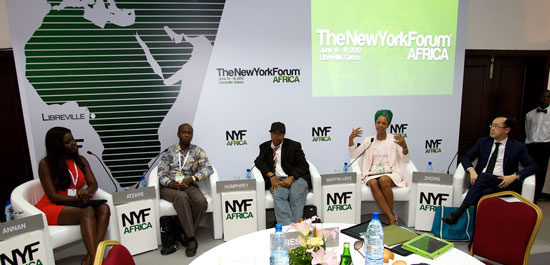LUXURY BRANDS: The growth potential of labels – imported and exported

SUMMARY PAPER
by Fope Adelowo, Harvard Business School
Christine Esangbedo, Harvard Business School
Kiran M-Ray, School of Oriental and African Studies, University of London
TASKFORCE 7
LUXURY BRANDS: The growth potential of labels – imported and exported
Africa's rapid growth, booming cities and an aspirational middle class, are prompting luxury brands to look at entering new markets on the continent, despite the complexity of doing business in Africa, and the difficulty of finding suitable sites for their luxury stores. But the growth of the luxury market is tipped to be much slower than in the Middle East, even though the total investable wealth of high net worth individuals in Africa totaled $1.1 trillion in 2011, compared with $1.7 trillion for high-net worth consumers in the Middle East.
- What are some of the lessons to be learned?
- How do luxury brands need to customize their offering – and their marketing?
- Is there reciprocal growth in luxury home-grown brands?
Speakers:
ROBERTA ANNAN, Africa Chair, Fashion 4 Development, United States
RUBEN ATEKPE, Executive Chairman, Merchants Company of West Africa, Ghana
GENTRY HUMPHREY, Sportswear, Footwear Business Director – Basketball and Football, Nike, United States
SWAADY MARTIN‐LEKE, Founder and CEO, YSWARA Luxury Tea, Ivory Coast
PATRICK ZHONG, Senior Managing Director, FOSUN International, China
Moderator:
ISABELLE KUMAR, Presenter, Euronews, France
Summary
The luxury panel opened with introductions from the five panelists, highlighting their backgrounds and what they hoped to bring to (and learn from) the panel discussion. The conversation then began with a discussion on the challenges of bringing the currently niche market of African luxury to a larger scale in the next 5 -1 0 years. Isabelle Kumar led the panelists into a discussion around demand for African luxury goods. Panelists expressed their views re-assuring the audience that there was demand for luxury goods on the continent; however, understanding the consumer’s needs in the luxury category was key to being successful.
Gentry Humphrey spoke form his experience at Nike, explaining to the audience that Nike’s success has been driven by its ability to tap into the culture created around sports, hip-hop and fashion. In his opinion, being able to understand this culture, the lifestyle associated with it and providing consumers with a way to express this is what the luxury industry is all about. Swaady Martin-Leke echoed this concept and told the audience that if a brand represents a dream for consumers, it would be able to define a space for itself in the luxury category.
An interesting question was raised around the ”Made in Africa” stigma and how difficult it has been to get rid of this stigma and the impact it could have on the future of the African luxury Industry. Patrick Zhong provided some good anecdotes from China’s experience with “Made in China” brands and the positive change in the attitudes of Chinese consumers to these brands. In his opinion, this change was brought about by the increased quality of locally made products. He ended his comment by citing high quality goods and selling a good story as two important factors that will certainly help change consumer’s attitudes towards local products.
This led to a discussion about packaging and its importance in creating a luxury brand. Swaady Martin Leke stressed the importance of packaging in creating not just the physical product but the experience that comes with a true luxury product. However, it was clear that this was one of the more expensive parts of the production process. The issue, which was echoed by other panelists, was the high cost of quality packaging as well as high transportation costs, which were a significant challenge for getting goods from the continent to the rest of the world. Ruben Atekpe cited the importance of using existing distribution channels to reach consumers, mentioning that the demand for products obviously existed as proven by Nigerians’ place as the fifth largest group (by geography) of shoppers at Selfridges in the UK.
The discussion ended with panelists giving their advice to entrepreneurs looking to start their own luxury brands. Roberta Annan encouraged the audience to focus on quality. Ruben asked the audience not to underestimate the power of packaging. Swaady touched on the importance of hard work and doing one’s homework on the culture and Patrick took this one step further, stressing the importance of understanding one’s product and its value. Patrick closed the discussion by saying to the audience: “Don’t limit yourself. Think globally and universally”.
Challenges for local luxury goods manufacturers
- Producing goods of international quality and universal appeal: Firstly, panelists discussed that to become established, African luxury goods makers must meet international quality standards despite the extraordinary challenges they face in their markets. In addition, they highlighted that local producers must develop goods of universal appeal while maintaining an African identity in order to reach consumers in diverse regions within Africa and beyond Africa.
- Skills development: Another challenge that was highlighted was the lack of skills to manufacture and deliver luxury goods. Participants discussed areas in which Africa still needs to build expertise. The most important areas for development mentioned were large-scale manufacturing and marketing.
- Infrastructure: A third major challenge that was highlighted was the lack of infrastructure. Panelists discussed how these challenges have resulted in higher costs of manufacturing and distribution and thus, a squeeze on the profits that luxury goods makers can capture.
- Lack of retail space to deliver a luxury experience: In line with poor infrastructure is the lack of commercial real estate to deliver a luxury retail experience. Panelists mentioned that Africa still lacks retail space of the kind that one can find on Fifth Avenue in New York, which is essential to delivering a luxury experience.
- Distribution: A panelist highlighted that it costs six times as much to ship 1 kilo from Johannesburg to Lagos as it does to ship 1 kilo from Paris to Lagos. For indigenous African companies looking to expand within Africa, these costs are prohibitive.
- Overcoming the negative perception of Made in Africa/African goods: Lastly, much of the discussion surrounded the negative perception of Made in Africa goods that exists in Africa and abroad.
Solutions for local luxury goods manufacturers
Producing goods of international quality and universal appeal:
o Developing infrastructure and finance-focused on consistency and scalability of products; Investing in brand management, advertising, packaging and PR.
o Tap into the mindset of the customer and create an aspirational story that is relevant to the African consumer but also to an international audience. Patrick Zhong gave the example of a Hermes tie he was wearing whose design had incorporated lucky Chinese symbols. Therefore African designers must relate to other cultures to be relevant internationally and move away from tribal and ethnic stereotypes.
o Working with artisans who use heritage craftsmanship but updated with contemporary designs.
Skills development
o The core craftsmanship skills of luxury are present in Africa but service skills need to be improved.
o Keep the value added within Africa to build capacity and infrastructure.
Infrastructure & Retail Space
o Collaboration: work with partners to create a shared retail space. In Europe, luxury brands tend to be located together.
o The entrance of top luxury hotels in Accra, for example, has made it easier to persuade global luxury brands like Gucci and Chanel to enter the African market as have purpose-built malls with brands like Nike and Apple.
Distribution
o Look into ways of exporting the products in a globally competitive way. For example Swaady Martin-Leke described establishing dual assembly centers to help overcome transport costs.
o Know your markets: aspirational consumers versus consumers who buy for intrinsic value of Made in Africa products.
Overcoming the negative perception of Made in Africa/African goods
o Focus on improving quality of locally made products.
o Sell a good story. Understand the value in your product and craft a good story around it which can be sold
o Seek endorsement from African and international celebrities.
Taskforce 7: NYFA Luxury Panel 2-page Summary
Key Statistics
GDP Growth: Africa has experienced positive GDP growth over the past decade. The International Monetary Fund estimates that Africa has experienced a non-oil real GDP growth of 5.4% from 2007 to 2012.
Urbanization: 50% of Africans are expected to reside in urban centers by 2025 according to a report by Ernst & Young. McKinsey & Company further reports that there are 52 African cities with a population of at least 1 million. Growth in urbanization will drive more demand for goods and services.
Rising consumer expenditure: McKinsey & Company reports that 128 million African households are projected to have discretionary income by 2020 –more than half of African households. Consumer expenditure by African households is expected to reach $1.4 trillion dollars by 2020.
Wealth: Africans are becoming wealthier. According to the Knight Frank Wealth report, the number of high net worth individuals (HNWI) in Africa grew by 18% from 2012 to 2011. It is expected to grow 69% over the next decade. Growth in wealth will stimulate demand for luxury products and services.
Recent Developments
Conversations: An increasing number of conferences are focusing on Africa as the new luxury market. One such conference that was held last year is the International Herald Tribune, Luxury Society Conference. The theme of the conference was the ‘The Promise of Africa, the power of the Mediterranean’ It created a forum for the various players in the global luxury field to discuss the potential of Africa as a luxury market, bringing the continent to the forefront of the minds of the influential business men and women present.
Entry into the Market: A few international brands (e.g Ermenegildo Zegna is slated to open up stores in Nigeria, South Africa and possibly Angola) have established their brand’s stores in some African countries. Their success has recently caught the attention of various international players, who are now watching and waiting for the right opportunities to establish a presence in these markets.
High Profile Champions: Press coverage around the celebrities who champion various luxury products (e.g Bono and Ali Hewson for Edun) can be favorable for raising the profile of the region as a destination for luxury products.
Challenges Ahead
We believe the challenges in the luxury industry can be viewed from 2 different lenses:
- Local Luxury Designers & Retailers
- International Luxury Brands
Indigenous Luxury Designers and Retailers
Cache of “Made in Africa”: One of the challenges facing local designers is the perception that
‘made in Africa’ somehow signifies products of lower quality. This of course is a challenge for designers seeking to differentiate their brands and who go to extensive lengths to procure the highest quality products. The high costs that goes into designing, producing and packaging goods is lost in the negative perception that locally produced goods attract. This results in low volumes and limits the designer’s ability to charge higher prices.
Packaging: Several luxury consumer goods are faced with the challenge of sourcing the right packaging and establishing the right packaging partners for their products. Given that in the luxury industry, packaging is as much about the product as the product itself, this poses a challenge for businessmen trying to create a unique identity for their products.
Supply Chain: Transportation of inputs and finished good remain a challenge, particularly at the inter-country level. This severely limits distribution potential of products as achieving cross- regional penetration is very expensive.
Retail Outlet (cost of real estate): In many of the more populous states, Nigeria, South Africa, Angola – finding attractive real estate locations for physical stores can be challenging and property is often very expensive. Furthermore, workmanship needed to convert ordinary spaces into a luxury playhouse is very limited. Designers struggle to find the right balance between image and location.
Low Volumes: Discretionary spending locally is low and where it exists, is often directed towards international brands which are strong social status symbols.
High Financing costs: For entrepreneurs seeking financing for capital expenditures and working capital, access to funds is limited and expensive. Debt financing through banks is extremely expensive, which limits the scale to which an entrepreneur can expand his or her business.
International Luxury Brands
Many of the challenges listed above apply here too. However, there are a few issues that particularly pertain to international brands looking to enter African countries.
These are:
Local Partner: Finding a local partner can be a tough feat for any international brand. However, this is key for navigating one’s way through the political and economic environment in many African countries.
Import Substitution Initiatives: As governments seek to create jobs, stimulate local demand and move to a more diversified economy, there could be several negative implications for international brands. This could come in the form of higher taxes or tariffs on imported goods.
Opportunities
Serving 1 billion people: The population of Africa in 2011 was 1.03 billion representing a large market. As GDP per capita increases, Africans will demand more goods and services of better quality. An important market in the region is Nigeria boasting a population of 170 million and a real GDP growth rate that has averaged 7% the past 5 years and is projected to continue on this growth trajectory. Local and international manufacturers and service providers stand to benefit. Nigeria, for example, is the 17th largest market for champagne in the world according to a Financial Times report.
Travel: Africa will attract an increasing number of business travelers and tourists. As a result, the continent will require more hotels, resorts and attractions of global standards. This presents an opportunity for international luxury hotel brands to expand across Africa.
Serving the global population: Africa will become more integrated in the global supply chain.
Through an International Trade Centre initiative, small communities are supplying international fashion houses such as Stella McCartney. Expansion of this initiative will have implications for Africa as a producer of luxury goods. The opportunity to export indigenous made goods, for example fashion and textiles, internationally is still largely untapped.





